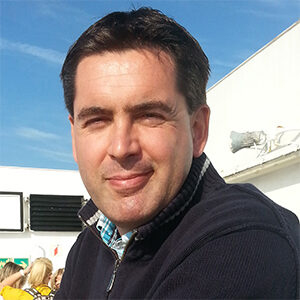Reaching the limits of expansion for German broiler farmer

The broiler and beef cattle farm of Andreas Fleer has grown extensively over the last 20 years to 360,000 broiler places, with 1,00 bulls and 400 rearing bull calves. Meanwhile, the farmer has invested in saving energy, and modernisation. Optimising the existing operation is key as it will be very difficult, or even impossible, to expand at the current location.
Andreas Fleer took over his parents’ company in the German town of Wietmarchen in phases. First, 50% of the beef bull operation was transferred to him in 2005. He took over the remaining 50% and the entire broiler operation in 2022. The 360,000 broilers are kept in 8 houses. The company’s broiler branch has grown rapidly since 2005 when the Fleer family had 80,000 broilers. Today there are 160,000 broilers at the home site with another 200,000 just 1 km away at the second location.
The the rapid growth of the broiler farm was made possible by phasing out the dairy branch of the company. Fleer explains: “The reason for this is that expanding the dairy branch in 2005, which had 25 dairy cattle at the time, would require far too large an investment and subsequently yield too little return. To become competitive, we would have had to buy expensive milk quota, build a large new free stall barn and buy more dairy cows.”
So the money was put into expanding the broiler operation instead. The beef bull branch has also grown rapidly, with only 200 bulls in 2005 and now 1,000 bulls and 400 rearing bull calves. The last dairy cows left the farm in 2008.
Test farm
The Fleer family switched from Cobb 500 to Ross 308 birds in 2005. The German broiler farmer certainly does not plan on switching to another breed or brand for the time being. “Ross 308 is very popular and there are currently too few day-old chicks on the market, so that is another reason to stick with this breed.”
The Fleer family has served as a test farm for the Belgian hatchery Belgabroed since 2017. They conducted trials for about a year with Belgabroed’s NestBorn concept in which the hatching eggs are hatched in the house itself. An interesting concept, says Fleer: “I considered applying this concept because it certainly has advantages, but later the hatching process at my Dutch hatchery, Chick hatchery Van Hulst, was adjusted and since then the quality has been comparable to the NestBorn chicks. And because on-farm hatching occupies the house for 3 days longer, I decided not to do it.”

The German broiler farmer is proud of his current technical results. The FCR over recent flocks has averaged at around 1.48-1.52. He has a low mortality rate of 2-3%. The male and female broilers are fattened until they weigh approximately 2.6 kg. In the meantime, the family thins the flock twice, the first time on day 29 and the second time on day 34 or 35. A flock remains for a maximum of 42 or 43 days.
If Fleer wants to use antibiotics, he has to report this to a German government agency. “Fortunately, we are always in the safe zone. Companies that use antibiotics too much must take steps to reduce their use.”
In Germany, animal welfare and environmentally-friendly production are important themes. Yet Fleer is not considering switching to slow-growing broilers in the long term. “Firstly, I can achieve the greatest return with the current generation of broilers. Secondly, the footprint of the broilers I now use is many times better than that of slow-growing broilers.” The German broiler farmer now has 39 kg of broilers per m2.
Gas consumption halved
The Fleer family decided to install a Plettenburg heat exchanger in 2010. “The reason for doing that was the better air quality in the house – both for the animals and the farmer – and much lower energy costs. I now use about 50% less gas.”
The family also installed a total of 950 kWh of solar panels between 2009 and 2015. This electricity is sold for prices between €0.24-0.38 per kW due to the favourable subsidies in Germany for supplying electricity to the grid. To reduce on-farm power consumption, Fleer invested in LED lighting in all the houses.

With every investment, Fleer aims to make his operation future-ready. That said, in light of the German and European demands placed on livestock production, Fleer does not expect to be able to obtain a permit for further growth at his current main location. If he ever wants to expand, he will probably have to buy an existing broiler farm some distance away.
According to the German poultry farmer, the inability to expand poultry farms and staff shortages on farms will become a problem over the next 10 years. “Given the negative future outlook, I fully understand the large-scale protests and demonstrations of our French colleagues. Even though it is becoming increasingly difficult to run an agricultural business in Europe, we have to get home the point that local food production is important.”












